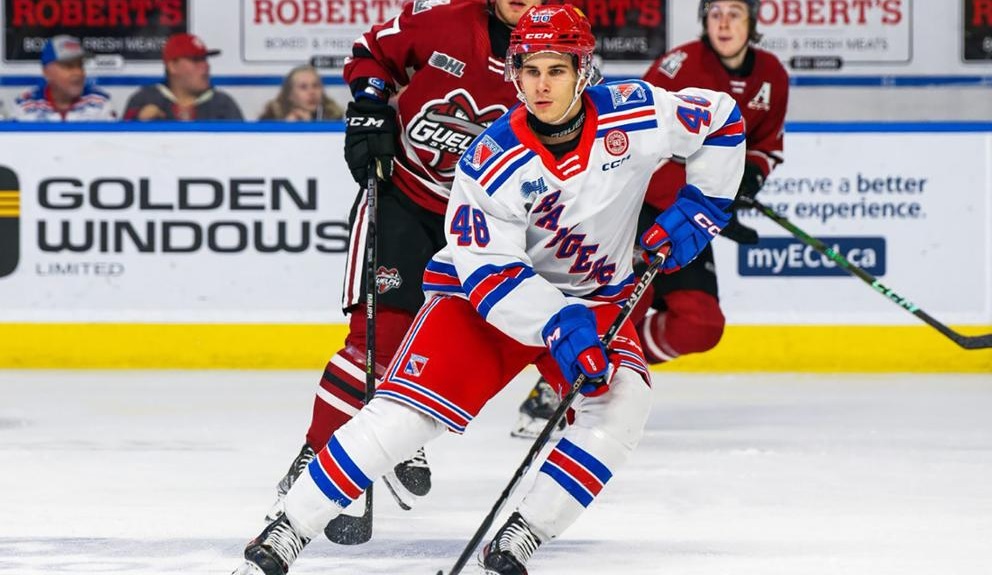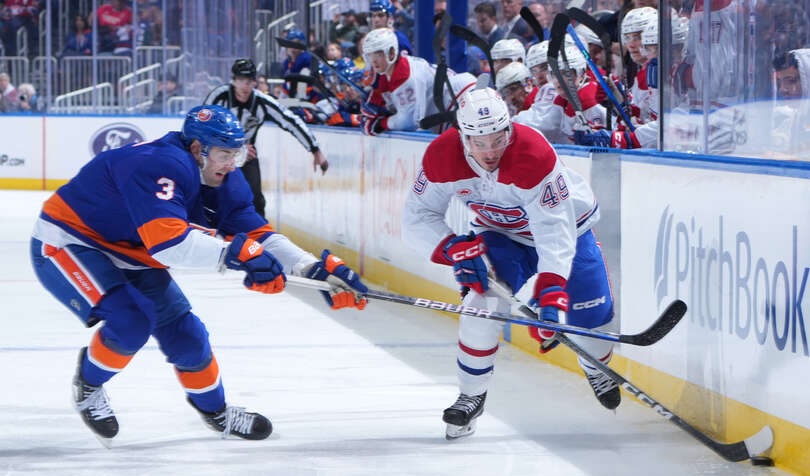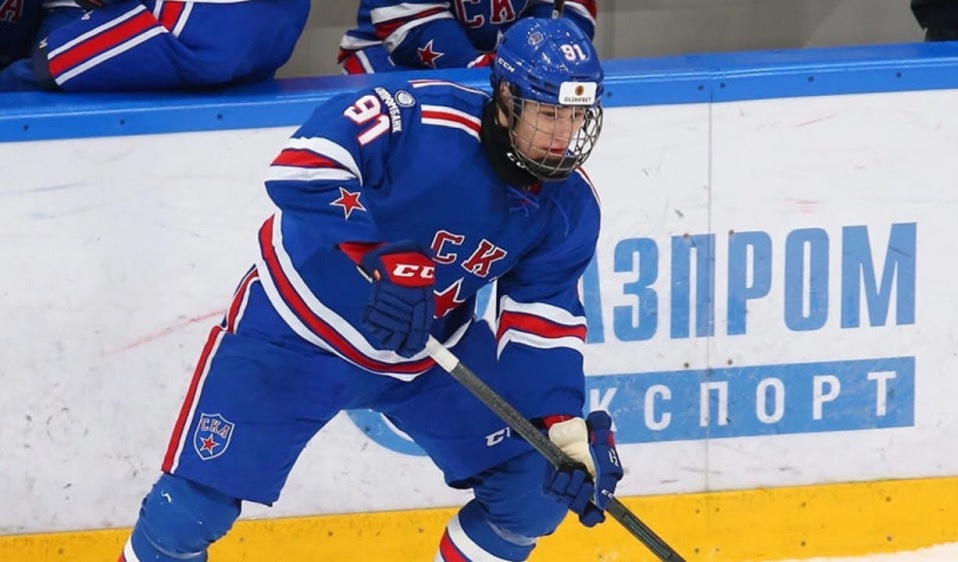HabsWorld.net --
We have finally reached the top five of our 2022-23 prospect rankings. Some of these players have gone out and now established themselves as regulars and won’t be on this list next season while others still have a ways to go in their development but have high ceilings.
Overview
Here are the criteria that each player had to meet to be eligible to be in these rankings:
1) The player must be 24 years old or younger as of October 1, 2022
2) The player must have no greater than 50 games of NHL experience (including regular season and playoffs)
3) The player cannot be signed to an AHL contract
Here are the departures from last year’s list (previous ranking in parentheses):
Graduated – NHL GP: Cole Caufield (1), Samuel Montembeault (23), Michael Pezzetta (29)
Graduated – Age: Otto Leskinen (35)
Traded – Ryan Poehling (9), Cam Hillis (32), Michael McNiven (40)
Released – Kale Clague (16), Josh Brook (19), Brett Stapley (24), Jacob Olofsson (36)
Included with each ranking is an estimate of the NHL readiness date for each prospect. For some players, the estimate is a specific season while others whose projected development paths are harder to determine will be in a range. Players are assessed on a combination of upside, likelihood of making it to the NHL, and overall value to the organization. The rankings were set in November (the write-ups take a while) so early-season performances have been taken into consideration but as they are small sample sizes, they only move a player up or down a few slots.
Rankings
5) Filip Mesar
Right Wing, Poprad (Slovakia)
1st round pick (26th overall) in 2022
If you were to think back to the way teams played in the NHL ten years ago compared to now, one of the biggest differences that should come to mind is speed. At no point has the game ever been faster with transition play being more important. I suspect that played a big role in Mesar being picked in the first round as speedy transition play is a big part of his game.
Playing against men back home the last couple of years was both good and bad for him. The good is that he was exposed to a higher level of physicality, closer to the level that he’ll see in the NHL and AHL. As an undersized player (Mesar stands 5’10), there’s a lot of value in getting game reps to learn how to overcome that and how to lean into his speed to compensate.
However, it’s also fair to suggest that playing in the Extraliga also limited Mesar’s offensive touches. Skill players need lots of minutes in offensive situations. He didn’t get a lot of that. Between that and his size, I think that’s what pushed him down a bit in the draft.
There’s a lot of work to be done on his all-around game as well. When he’s focused, Mesar is more than capable of playing a defensively conscientious game which certainly is enough to earn him a long look in the NHL. Doing so with consistency is proving to be a bit of a challenge.
There’s absolutely top-six upside offensively with Mesar. The raw skill is there, he has a good shot, and he’s already a strong skater. Frankly, the way he plays fits in extremely well with what Montreal seems to be going for as a quick, up-tempo team that relies heavily on transition play. But for someone who has two full professional seasons under his belt, he feels like a bit of a project prospect, one that needs to shore up some of the basic fundamentals before really being ready to push for an NHL spot. He should get the chance to do that over the next few years.
2021-22 Stats: 37 GP, 8-8-16, -4 rating, 8 PIMS
Previous HW Ranking: N/A
NHL ETA: 2025-26 – Mesar still has another year of major junior left after this one. If he uses it, I think he’ll need it plus a year in Laval to make it. If he goes to the minors next season, it’d be preferable for him to get two years down there.
4) Logan Mailloux
Defenceman, London (OHL)
1st round pick (31st overall) in 2021
From a development perspective, there are certainly concerns. I’m not talking about the off-ice stuff which made him a polarizing selection but rather the lack of playing time the last two seasons. Between a half-season suspension for what happened in Sweden and then being injured in a fight, Mailloux was limited to just 12 games last year. After playing zero OHL contests the year before, it’s basically two development years squandered. How much of an impact will that have? There isn’t a lot of precedence for high-end prospects to compare to.
Offensively speaking, Mailloux is highly talented. He has a cannon for a shot (though it’s a bit wild some nights), is a strong passer, and is a strong skater for his size, allowing him to jump into the play with a high success rate. It’s not hard to see the upside, nor is it hard to see him fitting in with the Canadiens who, let’s face it, badly need another offensive threat on the back end.
However, there’s also the defensive element to consider; it’s kind of important for a defenceman. At times, Mailloux shows the ability to read the play well and make the right decisions. That tells me he has it in him. But doing that consistently is a challenge, to say the least. Instead, he’ll take himself out of position frequently, make an overly aggressive play, or focus too much on a hit. These aren’t entirely uncommon issues for a young defenseman but the frequency with which they occur is concerning.
So, why is he rated this high, especially in rankings that were set in November? If everything comes together for Mailloux, he could be a legitimate top-pairing blueliner and there aren’t many in Montreal’s system that have that type of upside. Even if the defensive consistency doesn’t get there or the missed games prove to be a big issue, Mailloux has the ability to be a particularly impactful player simply with his offence. There’s plenty of promise if he can put it all together.
2021-22 Stats: 12 GP, 3-6-9, +7 rating, 13 PIMS, 45 shots
Previous HW Ranking: 3rd
NHL ETA: 2024-25/2025-26 – Physically, Mailloux could step into the NHL right away but they’d be better off being patient with him and letting him get some reps in with Laval for a year or two.
3) Justin Barron
Defenceman, Montreal (NHL)
Acquired in a trade in 2022
Fans got a good look at Montreal’s key trade deadline acquisition last season as he was brought up following the deadline and never actually made it back to the minors. To his credit, he didn’t look entirely out of place despite making an adjustment to a new team and system.
Barron is someone who fits the profile of the modern-day NHL defender. He is more about mobility and fluidity compared to a big, physical blueliner and there are enough raw offensive skills to give him some upside at that side of the ice.
Offensively, his shot is decent while he’s a good puck-mover, both through passing and skating. He’s more than capable of jumping up into the play offensively, a trait that the Habs seem to be putting a lot of emphasis on as they become a team that really leans into trying to score in transition.
The question for him will be in his own end. Barron is prone to some untimely mistakes and with minimal time in the minors, he’s learning the hard way on some of his bad decisions. Again, that’s not uncommon for a young defenceman but it is an area of some concern at the moment that has the potential to limit his upside if it’s not cleaned up down the road.
In terms of pure upside, Barron is behind Mailloux but he also has a better chance of playing a top-four role in the NHL on a steady basis. The lack of an elite skill makes him more of a complementary blueliner but if he can fit the style that the Habs want to play and push for 18-20 minutes a night on the right side of their back end, Barron has the chance to be a core piece for Montreal for a long time.
2021-22 Stats (AHL Colorado): 25 GP, 7-9-16, -3 rating, 6 PIMS, 56 shots
Previous HW Ranking: N/A
NHL ETA: 2023-24 – This is pretty self-explanatory. Barron spent a fair bit of time in Laval this season but should be in line for a full-time spot next year.
2) Kaiden Guhle
Defenceman, Edmonton (WHL)
1st round pick (16th overall) in 2020
Heading into this season, Guhle was the definition of an NHL-ready defenceman. I don’t throw that term around loosely either, especially for defenders as generally speaking, I prefer most rearguards to spend time in the minors. But Guhle was the exception and if you’re reading this, you already know why.
Defensively, Guhle has a bit of a throw-back element to him in that he pays attention to the little details in his own end, making him a very steady and consistent player on that front. He also certainly plays with a physical edge, something I expect will become more prominent as he gets acclimated to playing in the pros. Just on the defensive side of his game, Guhle can be an important NHL piece.
But, of course, there’s more to his game than just his own zone. Guhle is surprisingly mobile for a bigger defender which allows him to attack in transition (and, more importantly, get back if the opponent has a rush chance the other way). He’s a better shooter than his goal totals in junior might indicate and he has a knack for getting shots through over just teeing it up and hoping for the best.
I’ve long felt that Guhle’s best role is on the second pairing, one that puts him in a situation where he isn’t necessarily fixed into a certain style. He can be a true shutdown player but that limits him offensively. If you have him with the top line (an offensive trio), they might be underutilizing his defensive skills. Either way, Guhle should be a foundational part of Montreal’s back end for the long haul.
2021-22 Stats: 42 GP, 7-33-40, +22 rating, 57 PIMS, 150 shots
Previous HW Ranking: 2nd
NHL ETA: 2022-23 – No point in going into details here.
1) Juraj Slafkovsky
Left Wing, TPS (SM-liiga)
1st round pick (1st overall) in 2022
While his draft class wasn’t exactly hyped up, Slafkovsky’s selection with the top pick pretty much guaranteed he’d get the top spot here.
It’s easy to see what Montreal’s logic was in picking him. Power forwards don’t grow on trees and they’re quite difficult to acquire. Slafkovsky, as a draft-eligible, already had the size of a true power forward and with his performances internationally, showed the offensive skills to make the Habs and other teams believe that he has the upside to be an impact producer as well.
Having had a somewhat limited role in the Finnish league, Slafkovsky is much more of a project than a typical top selection, even with an NHL-sized frame. For a team that is building to emphasize speed, he’s not a particularly strong skater, plus he has a tendency to put his head down, one that has gotten him in trouble already. There’s room for improvement on both of those fronts.
Offensively, Slafkovsky does well to protect pucks on the boards and is more than willing to get to the dirty areas, elements that the Canadiens certainly need. He uses his size well to create space with the puck on his stick and he has a decent shot that should improve over time. Defensively, there’s a good foundation to work with although, like many young players, he gets caught puck-watching a bit too often.
While this probably doesn’t read like a glowing scouting report (especially compared to someone like Guhle above), it highlights how much projectability there is to his game still. If Slafkovsky develops to his potential, he’s a top-line power forward, making him a pretty rare player in the NHL that’s more than worthy of this ranking. But he’s a long way away from getting there. The range of outcomes is pretty wide as if he doesn’t show a lot of improvement, he could just be a bottom-six player down the road which wouldn’t be a great return from the number one selection. There’s lots of room for optimism but Slafkovsky is a few years away from showing if he’s going to live up to the hype.
2021-22 Stats: 31 GP, 5-5-10, +1 rating, 33 PIMS, 89 shots
Previous HW Ranking: N/A
NHL ETA: 2022-23 – For better or for worse (and I’d say the latter), Slafkovsky was a full-fledged regular this season.


